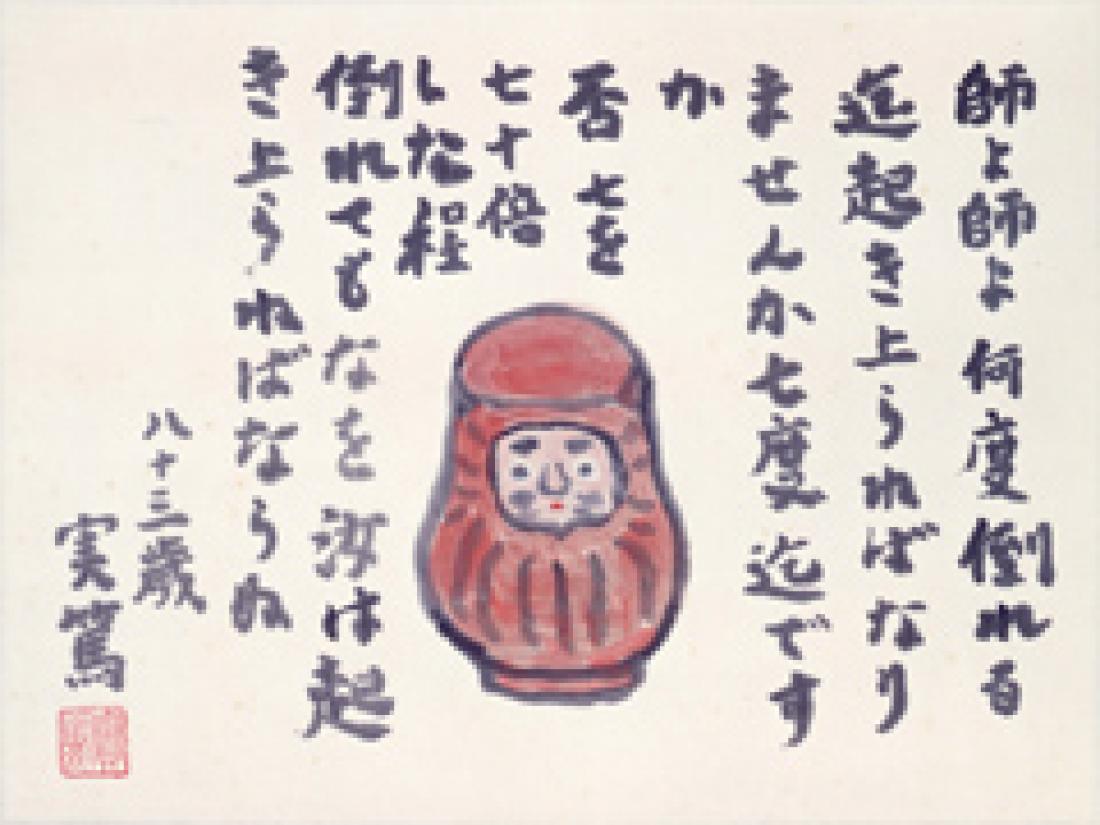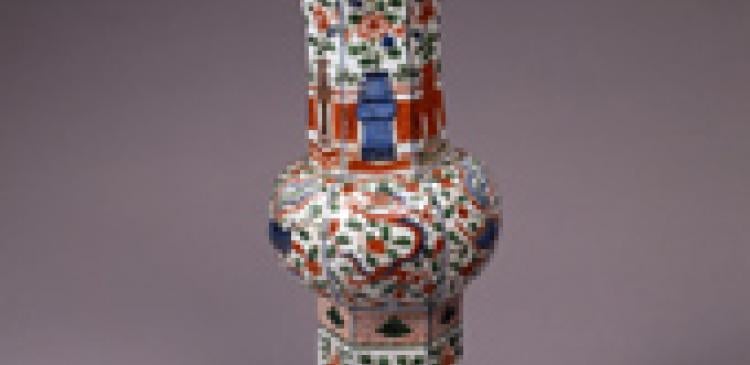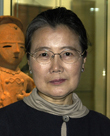By Kyoko Asai, Professor at the Aizu Museum, Waseda University
I remember many homes in the mid 1960s to the mid 1980s having square pieces of fancy paperboard, calendars or decorated plates with the works of Saneatsu Mushakoji, familiar vegetables and flowers like pumpkins and roses and accompanied with phrases such as “every day is a good day.” It is said that Saneatsu Mushakoji (1885-1976), a renowned novelist, took up painting when he was 38 (1923). His first works were pencil or ink wash drawings of scenery or familiar objects, and of those some copies from Durer still remain. He said, “literature is the world of words, but pictures are the world of silence.”(“Preface”, Six Modern Arttists, 1963) As he was a novelist who uses words to express himself, he probably described pictures, which enables him to become one mind in a world free of words, as the world of silence.
Saneatsu also wrote the following about his thoughts of his painting. “I love pictures I can devote myself to with pleasure. I love them because I can’t live by not loving them. At the same time, when I draw pictures, I am struck with admiration of the subject. Whether I am painting a potato, a pumpkin, or an onion, I don’t take them as simply something I can paint. I think that somehow I want to portray that object to the best of my abilities. If I can truly paint these, I could become great artist. Although I still don’t have enough skill, I want to at least express all my energy. If there is a redeeming feature to my pictures, that is it. And I always take it seriously. Due to that, however, I’m got tired quickly. I want to be more relaxed in expressing my energy, but I don’t want to destroy the character I was born with.
When I draw an oil painting, I can head toward the goal over and over again, but because Japanese style paintings are a one-off challenge, I do the work with much concentration. However there is a lot of straight forward work because of too many orders. Even so, I never get tired of doing repetitive work because I don’t lose the love and respect for my objects.
I have true respect for objects that people simply take for granted, and if there is said to be something characteristic of me; it is that even when I put in my greatest effort, I think I still haven’t done justice to the objects.
I think that my painting is the pursuit and discovery of beauty. I am enthralled that, through painting, I found that this world is overflowing with beauty.” (The Joy of Painting, 1957)
Apart from one small oil painting painted in his 60s, all the Saneatsu works in the Tomioka collection are works from his 70s and 80s, with the contours of kitchen vegetables or seasonal flowers drawn in Japanese ink and colored with pigment. The ink lines of the shape are drawn carefully, as if carving out the shape. And many of the works are accompanied by phrases such as “The Joy of Blooming Together.” Of these, one work titled “Master! Oh, Master!”, has the words written at the bottom center of this page as if they encircle a small daruma. I hear that this work was painted by Saneatsu as a present to encourage Shigenori Tomioka’s wife, who was battling illness at the time.
By the way, Saneatsu was a member of the Shirakaba (White Birch) School of Japanese Literature, and he introduced works from the West by the likes of Rodin and van Gogh in the magazine “Shirakaba”. There is also a novel titled Wanli Red Porcelain, written by Naoya Shiga (1883-1971), his classmate and close friend from sixth grade at Gakushuin Boy’s Junior High School. Shirakaba fellows, who are also mentioned in this novel, had a love for the five-colored Ming Dynasty porcelain called Wanli red porcelain. From the works of Ryuzaburo Umehara (1888-1986) in Saneatsu’s Six Modern Artists, there is a still-life painting of a rose on a Wanli red porcelain vase. The vase used here is the same shape as the Ming Dynasty mark Wanli porcelain vase, “five color dragon and phoenix inscribed zun vase” (height 46.9cm), in the Tomioka Collection. The shape of the ancient bronze vessel called zun has been reproduced with alternating pictures of a dragon and phoenix on the curved part of the body of the vase.
Five-colored porcelain is made by being painted designs on white porcelain in over-glazed colors such as red, yellow and green, and it is finished by being baked at low temperature. The porcelain flourished in the Ming Dynasty. It may be called “five colors”, but actually means “painting in many colors”, and is by no means limited to the use of five colors. Appearing in Chinese literature, it is a word that came into use in porcelain history research from modern times onwards. This method has been called “red porcelain” in Japan since the Edo period. The Tomioka Collection doesn’t contain early Ming Dynasty five-colored porcelain and the porcelain called Doucai-style made in Chenghua period. The Collection contains the five-colored porcelain called ancient red porcelain that are made in the Zhengde(1506-1521) and Jiajing(1522-1566) eras. Ancient red porcelain is even older than Wanli red porcelain, and appears in records from the late Edo period. A major difference from other works is that it is adorned with pictures painted in three colors, mat yellow, red and green, and doesn’t use blue flowers. Wanli red porcelain is made in the Wanli period (1573-1620), with an even more diverse range in shapes. Many works from the Tianqi period (1621-1627) and Jiangsu red porcelain from the late-Ming and early Qing Dynasties are popular as tools for tea-making.
In this way, we have compiled an exhibition of Saneatsu works combining five-colored porcelain such as ancient red porcelain, Wanli red porcelain, Tianqi red porcelain and Jiangsu red porcelain from the mid to late Ming Dynasty. I hope to see you all at the exhibition.
Saneatsu and Red Porcelain
March 2 (Wed.) to April 23 (Sat.)
The Aizu Museum Shigenori Tomioka Collection Gallery (opening hours 10:00-17:00)
About the author: Kyoko Asai
Former Arts and Sciences manager at the Tomioka Art Gallery. Took up position at Waseda University in April 2004 and is currently a professor at the Aizu Museum.





